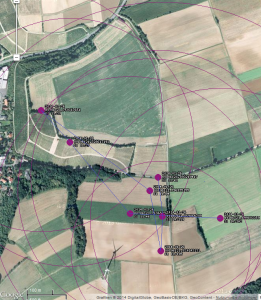Hi!
Just some interesting notes:
During winter season, the electricity in thunderstorms is often weaker but the cloud level over ground is lower too. Thus, the chance might be higher that lightning hits only very tall structures and not the area around that structure. During the last hours there have been a couple of such thunderstorms over Germany, where stroke coordinates are concentrated on a small area only. Participants can check that on Lightningmaps.org.
Here's an example:

The time, number of participated stations and the number of stations used for calculation is displayed aside each stroke. It was one single lightning flash and all it's strokes occurred within 200 milliseconds. They are all very close to the windmill at the bottom of the picture. The first stroke was the most powerful one, as it has been received from most stations (see attachment below). It's almost 100% sure, that some or all of the strokes hit this windmill. The real deviations to the target are in a range from 300 to 700m. Such an detection accuracy is only possible when there are some stations not too far away and not too close.
No other lightning stroke has been detected several kilometers around that windmill. There is a good chance, that there wouldn't have been any lightning strike at all without the windmill. Per definition, a thunderstorm is only a thunderstorm when there is lightning. Conclusion: More tall structures like windmills, power lines or antenna masts --> more thunderstorms, at least in winter. Sounds good (but don't take that to seriously !)
!)
Have fun!
Tobias
Just some interesting notes:
During winter season, the electricity in thunderstorms is often weaker but the cloud level over ground is lower too. Thus, the chance might be higher that lightning hits only very tall structures and not the area around that structure. During the last hours there have been a couple of such thunderstorms over Germany, where stroke coordinates are concentrated on a small area only. Participants can check that on Lightningmaps.org.
Here's an example:
The time, number of participated stations and the number of stations used for calculation is displayed aside each stroke. It was one single lightning flash and all it's strokes occurred within 200 milliseconds. They are all very close to the windmill at the bottom of the picture. The first stroke was the most powerful one, as it has been received from most stations (see attachment below). It's almost 100% sure, that some or all of the strokes hit this windmill. The real deviations to the target are in a range from 300 to 700m. Such an detection accuracy is only possible when there are some stations not too far away and not too close.
No other lightning stroke has been detected several kilometers around that windmill. There is a good chance, that there wouldn't have been any lightning strike at all without the windmill. Per definition, a thunderstorm is only a thunderstorm when there is lightning. Conclusion: More tall structures like windmills, power lines or antenna masts --> more thunderstorms, at least in winter. Sounds good (but don't take that to seriously
 !)
!)Have fun!
Tobias



